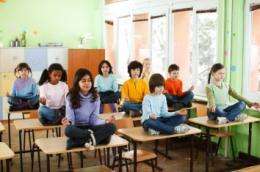Daily yoga regimen boosts socialization, mind-body connection, and focus among autistic students

Step one: Mats out. Step two: breathe deep. Step three: assume poses. Step four: tense and relax muscles. Step five: sing.
According to a study by NYU Steinhardt researcher, Kristie Koenig, these five steps, 17 minutes a day, five days a week, for 16 weeks, resulted in a significant decrease in aggressive behavior, social withdrawal, and hyperactivity for Autistic students attending District 75's P.S. 176X in the Bronx. The school serves the largest population of students on the Autism Spectrum in the nation.
"We found that teachers' ratings of students who participated in the daily yoga routine showed improved behavior compared with teachers' ratings of students who did not," said Koenig, assistant professor of occupational therapy. "Our aim in this research was to examine the effectiveness of an occupational therapy yoga intervention. Our research indicates that a manualized systemic yoga program, implemented on a daily basis, can be brought to public school classrooms as an option for improving classroom behavior."
"Get Ready to Learn," (GRTL) the intervention program used in the study, was designed by occupational therapist and yoga instructor Anne Buckley-Reen in 2008, in collaboration with Barbara Joseph, District 75 deputy superintendent. District 75 is the nation's largest special education district in an urban public school system. GRTL uses yoga postures, breathing, and relaxation techniques to help energize, organize and calm ASD students. It helps prepare students mentally and physically for the day's lessons.
"GRTL gets children out of the stressed state and prepares their brains and bodies to learn," Reen explained. "Children with Autism often exhibit characteristics of 'fight-or-flight' response. They are in a constant state of stress and struggle with staying calm, trying to concentrate, communicating clearly, or even controlling their movements. Many students with ASD and other challenges have missed critical developmental stages which impact body awareness and perception of self. How can we expect these students to connect to others, if they are not connected to themselves? GRTL provides opportunities to make and strengthen these mind-body connections."
With GRTL training supported by both the district and participating school, teachers led the daily routine that includes eight minutes of varied postures, three minutes of weight-bearing poses, three minutes of deep breathing to help reduce stress, three minutes of muscle tension and release, and concludes with a circle of song.
"This circle of song creates a vibrating of the lungs which helps students to find their voice and contribute to classroom harmony," said Reen. "We sing the name of the students in back and forth exchanges. This encourages engagement from all students, even those with limited speech."
GRTL is currently being implemented in more than 500 classrooms in District 75 across the city of New York with students ages five through 21 with significant disabilities. It is also in typical classrooms in Arizona, California, Connecticut, Illinois, Maine, Maryland, Massachusetts, Michigan, New Hampshire, New Jersey, and Vermont.
"This research points to new ways that can help students self-regulate their behavior for longer periods of time. This type of daily programming provides them with a foundation for function so they can focus and attend for longer periods of time. This is one way they are able to learn effectively," said Joseph. "Programs like this can enhance communication and socialization skills. Parents have seen changes in their children at home. They tell us they have seen improvement in their children's speech, communication, and behavior."
The study, conducted by Koenig, Reen, and NYU Steinhardt doctoral student Satvika Garg, is titled "Efficacy of the Get Ready to Learn Yoga Program Among Children with ASD: A Pretest-Posttest Control Group Design." It was recently published in the September/October 2012 issue of The American Journal of Occupational Therapy.















